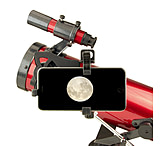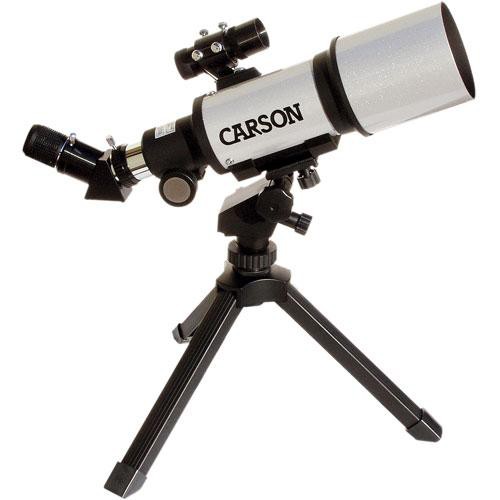

The middle eyepiece will be typically be harder to focus easily, since the focus range is smaller. The precision optics offer great images of the moon and planets, as well as views of bright deep sky. The SkySeeker Dobsonian mount telescope comes with 8mm and 20mm Huygenian eyepieces. Try adjusting thru the entire adjustment range slowly, and at some point, you should see the image appear, and sharpen up. The JC-200, SkySeeker Newtonian Reflector Telescope with Dobsonian Mount has precision 76mm Optics and a 15-37.5x power range for high-quality imaging. Carson Optical US 3.07K subscribers Subscribe 20K views 9 years ago Astronomy CarsonOptical The SkySeeker Telescope from Carson Optical has precision 76mm Optics and a 15-37.5x power. Try looking thru the middle size eyepiece at a very distant big object, that is much further away, like at least 1/4 or 1/2 mile, in daytime. When you use a smaller eyepiece, the magnification goes up, and usually, the higher power eyepieces may not work for close objects. The smaller ones will work the same basic way, but only for objects that are farther away. You're on the right track since you can see something with the large eyepiece. There is an excellent website for beginner telescope users at THIS LINK

Small scopes are often advertised as having unrealistic powers (300, 500) which can never be practically achieved. This will be more pronounced at higher magnifications. You will also find the the object you are looking at swims out of the viewing field, and you must continually move the scope to follow it. You will have to find planets, star clusters or nebula to see anything interesting. Looking at random stars will probably be disappointing, as they don't look different under magnification. Once you have done the above, you can try the scope at night, on an easy to find bright object like the Moon. It is possible to fit an erecting prism or eyepiece to most astronomical telescopes, and some of them come with one, but one wouldn't bother to do this with the small finder scope. Even if this is only slight, astronomers prefer to avoid it, and they don't really care which way up the Moon or Jupiter appear. There is a good reason for this- erecting the image needs more bits of glass in the light path, which reduces the amount of light and increases aberrations.
#CARSON OPTICAL SKYSEEKER TELESCOPE SERIES#
It is much easier to familiarise yourself with this in daylight.Īt this point you will learn that astronomical telescopes usually show an upside down image. Carson Optical SkySeeker Telescope JC-1000 By Carson Optical In Telescopes MSRP From 139.99 Carson Optical RD Series 10x34mm Compact Binocular RD-034 By Carson Optical In Binoculars MSRP From 174.99 Carson Optical Mini Aura Nightvision NV-200 By Carson Optical In Binoculars MSRP From 175. You will find that there is a very wide range of movement in the focus mechanism, because different eyepieces focus at different points, but the actual focus range for any eyepiece will be a small part of the overall range afforded by the focusing mount. The JC-200, SkySeeker Newtonian Reflector Telescope with Dobsonian Mount has precision 76mm Optics and a 15-37.5x power range for high-quality imaging. It is very difficult to do this job in the dark, especially as objects in the sky are constantly on the move.

Once you have a tree or mountain peak in the center of the main scope's image, you can then adjust the screws around the finder scope to get the crosshairs (or red dot) centered on the same object.
#CARSON OPTICAL SKYSEEKER TELESCOPE MANUALS#
Telescope manuals recommend that you do this in daylight, by pointing the scope at an object on the horizon and adjusting the finder to match (never point a telescope toward the Sun!). Carson Red Planet Series 45-100x114mm Newtonian Reflector Telescope with Universal Smartphone Digiscoping Adapter (RP-300SP),Large Visit the Carson Store 96 ratings 20 answered questions 25999 Available at a lower price from other sellers that may not offer free Prime shipping. The finder scope is meant to help you get the main scope lined up on the object you want to view, but it won't be any use in pointing the telescope until you adjust it to precisely line up with the main scope. Do NOT use the Barlow lens if one came with the scope. It is best when you are starting out with a telescope to try it with the least powerful eyepiece (the one with the highest number) to begin with, until you become more familiar with how it works. When the scope is not focussed, even if there are stars in the field of view, they will only be faint blurs. The higher the power of eyepiece on a telescope, the dimmer the image, the more difficult to aim it at any chosen object, and the more difficult to focus. The field of view is quite limited, especially if you are using a high power eyepiece. 1.New telescope users are taken by surprise at the difficulty of just pointing the telescope in the right direction to see anything.


 0 kommentar(er)
0 kommentar(er)
